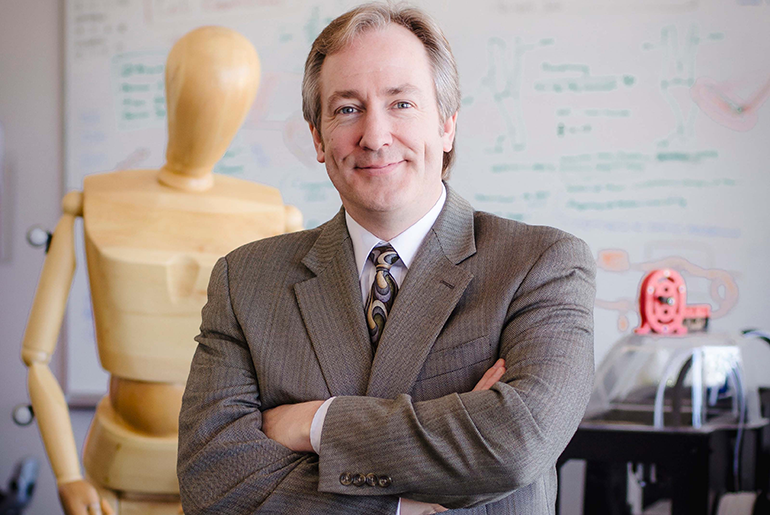
This article is the first in a series highlighting the research and educational endeavors happening at the Texas A&M Engineering Experiment Station’s (TEES) regional divisions. By building and nurturing relationships with its academic partners, TEES continues to assist in increasing their research capacities and enhancing research experiences for undergraduates.
When Dr. Donald Peterson packed up his life in Connecticut and headed 1,500 miles south to Texas, one of his intents was to expand research opportunities for students and faculty, and for himself, by joining the faculty at Texas A&M University-Texarkana. But once he began to settle into his new academic home, he discovered another beneficial—and unexpected—research advocate in the form of the Texas A&M Engineering Experiment Station (TEES).
Peterson joined the university in August 2014 as a professor of engineering and dean of the College of STEM. With degrees in aerospace, biomedical and mechanical engineering, he has published over 115 peer-reviewed scholarly works (including full-length articles, short articles and abstracts, and editing of textbooks and a major handbook) and developed devices for real-world use that are currently in the commercialization pipeline or have assisted in the design of spacesuits for NASA.
When he came to Texarkana from the University of Connecticut in 2014, a loyal group of graduate students followed him to Texas, to the STEM Innovation Laboratory, to complete their thesis and dissertation projects. Meanwhile, many of his former students are working at companies such as Medtronic, a global leader in biomedical engineering research, design and manufacturing.
“I have been truly in awe of the support and opportunities provided to me through TEES and have had the opportunity to make many solid connections I otherwise wouldn’t have made.” Peterson said TEES also has been invaluable in helping him rapidly navigate the patent process and provided guidance on licensing his technologies to companies.
That resource will also benefit his undergraduate and graduate students who are currently working on more than half a dozen initiatives that are likely to be supported with patent applications, cooperative business pursuits with industrial partners, or funding for additional research and development.
One such project involves the development of robotic exoskeletons for use by stroke survivors to restore proper function in those with neuromuscular impairments and localized injury. “About 800,000 people in the U.S. suffer from strokes each year. Eight in 10 stroke survivors are affected by hemiparesis or hemiplegia that causes partial or full inability to move one side of the body," Peterson explained. "Our clinical partners expressed a tremendous need for practical, low-cost solutions for their patients, which led to the development of a robotic exoskeleton that, we believe, can be produced for less than $100. We’ve seen the evolution of the project through three generations of development and we continue to enhance its functionality without impacting cost. For example, it’s currently in a stage that incorporates brainwave (or thought) control using electroencephalography (EEG), which we are very excited about.”
Other applications for the robotic exoskeletons include controlled and closely monitored exercises in microgravity environments to prevent muscle atrophy in astronauts, which is of interest to NASA.
"We’re now a part of the Texas Space Grant Consortium, which gives our faculty and students access to grants, NASA internships and other activities," said Peterson, who served as a campus director for the space grant program at his former institution. "We hope that membership to the Consortium will further encourage collaboration on and off our campus, in and outside of STEM, as faculty and students explore and engage in new research and development opportunities."
Peterson is working to strengthen an infrastructure that inspires and nurtures undergraduate and graduate student research and development. “In the past year, our design classes have evolved from a one-semester capstone course to a full-year senior design experience, where students have the time needed to tackle significant design challenges. And, we also encourage independent research credits for students who want to pursue research opportunities that are not embedded in their coursework, such as working with the advanced development of the exoskeletons,” Peterson said.
In the STEM Innovation Laboratory, student researchers will continue to use the 3-D printers to develop models that will be used to study cellular responses to fluid flow and to develop lost-cost medical devices, some of which are currently in the patenting process.
“I relocated to A&M-Texarkana because I see tremendous potential and, I believe, that this university has the best real estate in terms of our location and the easy access to Texas and our neighboring states,” Peterson said. “Our students are able to become involved in experiential learning from the day they step foot on campus. And with TEES’ support, I hope to be able to further my work and provide even more research opportunities to our undergraduate and graduate students and faculty through cooperative programs with the College Station campus. Opportunities that would otherwise not have been open to them.”
About Texas A&M University-Texarkana:
As a member of The Texas A&M University System, Texas A&M University-Texarkana is a comprehensive regional university that provides students with academically challenging, engaging and rewarding educational experiences through quality teaching, scholarship, student support services, co-curricular programming, research and service.
